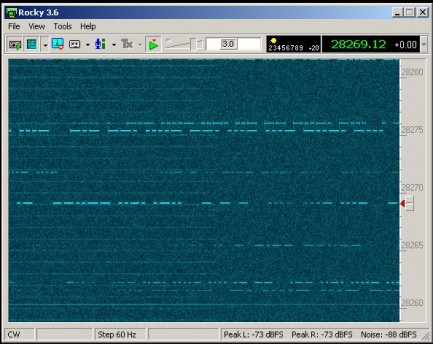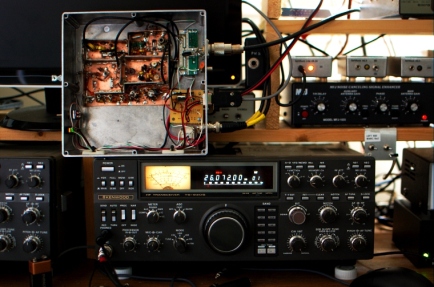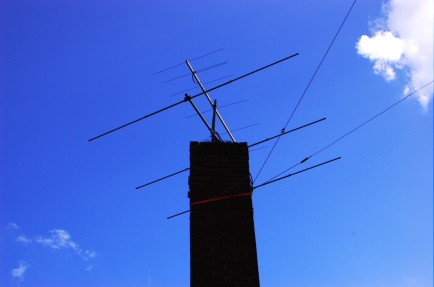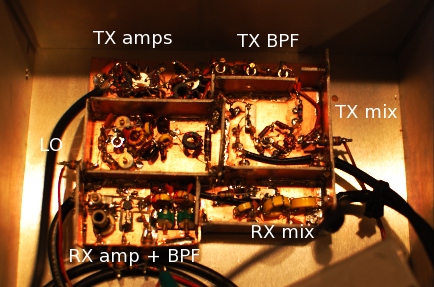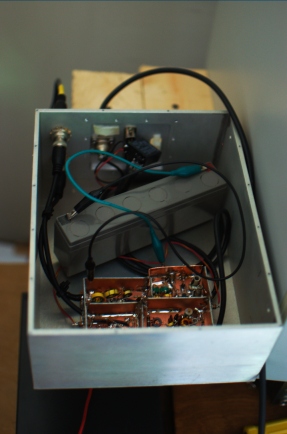Posts Tagged ‘50MHz’
 SoftRock v9.0 Lite+USB Xtall QRV
SoftRock v9.0 Lite+USB Xtall QRV
Got the SoftRock v9.0 Lite+USB Xtall working last night. I’m not 100% sure what the problem was, but I think it may have been due to me programming an ATTiny85 with the latest SoftRock firmware (V15.14), rather than using the supplied ATTiny45 with V15.4. So, I’m sticking with old version for now. Not sure if it was cockpit error on my part programming (more likely) or an incompatibility with the new firmware which is designed to work with the Ensemble series of SoftRocks.
As shown in the screenshot from Rocky above, there appears to be a spur that repeats every 1 kHz (see left side of the waterfall). The right side of the waterfall is with the USB cable unplugged from the computer. I’m 99% certain this is something internal to the SoftRock because I wrapped a few turns of the USB cable around a big type-31 ferrite toroid and the spurs are still there. So, need to play with that.
I’m listening to a Es opening to the south on 50 MHz right now using the SoftRock as the RX IF. Yes, that means that I got the RX on the transverter souped up a little hotter. I will post something about that later today and place a non-causal link in this post.
 Revisiting the 50-MHz Transverter
Revisiting the 50-MHz Transverter
I recently resurrected the 50-MHz transverter project and have made good headway getting it working. On Friday night, I began the process of tapping holes in the PA module heat spreader. But, despite using plenty of “cutting fluid” (3-in-1 oil), I managed to break a (well-used) tap on the first hole. Since the maximum (linear) power out of the driver stage is 200 mW, I embraced my inner QRPer and put the PA project aside to give the transverter a try in the CQ WW VHF contest.
The 6-meter Yagi had come down in favor of Yagis for 222 and 432 when the loaner FT-736R showed up. So, I scampered up onto the roof and moved Yagis around. I had hoped that this moment would be accompanied by changing out RG-8 coax for LMR-600 and LDF4-50A that are taking up space in the shop and shack. But, I was not ready to commit to cutting that and I still don’t have LMR-600UF for the rotator loops. Plus, I should replace the rotator at the same time. That amounted to too much work for the available time. I really just need to bite the bullet and install a rotating mast for the VHF antennas that’s not so precarious.
Got everything hooked up late on Saturday afternoon, but had to tend to some domestic concerns and was QRT until later in the evening when I heard my neighbor W4EE calling CQ on six SSB. Did not know that he had six! Apparently, this is a new thing for him, too. He was surprised that I didn’t vibrate his radio off the desk like I usually do! Told him I was running 200 mW and everything made sense.
Ended up working a few other locals on Sunday including N3UM, who moved me from 6-meter CW to 2-meter SSB for a quick chat. He just completed the N1DPM active bias mod to his Mirage B2518G, so was eager for an audio report. Sounds good! He said my B3016G sounded good on-frequency, but I haven’t gotten the mod actually inserted into mine yet. Probably that Kenwood (TS-700S) audio making up for the amp’s inferiority…
Eventually, I will be posting more details on the circuit here. This is one of those projects that I would not encourage anyone to duplicate as I have constructed it. However, there may be useful features.
 Recent tinkerings (9 Jan 2011 edition)
Recent tinkerings (9 Jan 2011 edition)
Several people have commented over the years that I should “write more” on the blog. I usually respond that I could spend my free time tinkering/hamming or blogging, but not both. Here are a month’s worth of blog posts as freestyle poetry:
- A section on my workshop has been added to k8gu.com under Engineering.
- Discovered that although the SoftRock VHF Ensemble II won’t fit (barely) into the Bud CU-473 diecast box I bought for it, it will fit into an extruded enclosure that housed an ancient X-band radar detector I picked up at Dayton in 2002 in hopes of stripping the Gunn diode assembly and getting on 10 GHz. Bonus points for thriftiness. Photos will follow once I finish the project.
- Did not observe Quadrantid meteor pings with the SoftRock VHF Ensemble II, but did notice something interesting about the W3APL beacon. Need to investigate.
- Have more CE/K8GU QSL cards again, finally. Tonight, I might finish the bureau (and, ashamedly one direct) cards languishing. Some K8GU (and AA8UP, no kidding) bureau cards are sitting here staring at me, too. Not a big project, though.
- Operated the NAQP CW on Saturday (8 January 2011) for four hours and twenty minutes and made 318 QSOs x 128 multipliers for 40,740 points before log-checking discounts. This total is pleasing to me especially considering that it was almost all leap-frogging SO2R search-and-pounce, which can be very fatiguing. It’s fun to see the rate meter stay over 100 when you’re S&Ping. Good Sprint practice.
- Still the best 30 minutes on the radio every week: I operated the NS Ladder on Thursday (6 January) night and made my customary 30 QSOs x 24 multipliers for 720 points. Hopefully, adding 160 will give me some momentum to increase this score back over 1000.
- We had a spell of 50F (10C) weather on New Years’ Eve. So, I put the 2-meter beam back up on the chimney. It was formerly mounted on a steel mast that was ratchet-strapped to the chimney. A strong wind (>50 mph gusts) before Christmas bent the mast (actually a fence top-rail) and I had removed it. I cut the bent lower portion of the mast off and attached the remaining top portion with rotator to a “girder” constructed from two pieces of treated 2″ x 4″ x 10′ lumber joined with a half-dozen lag screws. Again, I ratchet-strapped the entire assembly to the chimney. The present configuration is much stronger and less prone to damage. The 3-element 50-MHz Yagi is still on the ground until I actually get the transverter finished, which should be soon (as it has been for 12 months now).
- Repaired a SoftRock v6.2 downconverter for WF1L and learned that you can solder leads back onto SOIC packages if you’re careful.
- Have had delightful exchanges with KN6X and ZL1CDP about repairing the TS-930S. Some of these discussions (and their fruits) may make it onto the site at some point.
- Back in December, I started integrating the W1GHZ transverters using UT-141 semirigid jumpers with pre-installed SMA connectors obtained on attractive terms from Max-Gain Systems. Mitsubishi RA18H1213G (1296 MHz) and RA30H0608M (50 MHz) modules arrived from RF Parts. May have a lead on something less expensive with more gain for 903 MHz via HA1AG. The big remaining tasks in all three transverter projects are the sequencer and IF interfacing.
- Also in December, I had dinner with NS Ladder father Bill, N6ZFO, in San Francisco at the Hyde Street Seafood House & Raw Bar, which is a favorite of NA Sprint father, Rusty, W6OAT. Yes, I did feel that I was in the presence of greatness. (I had their excellent pork chops since I’m not into seafood, especially raw seafood.) Like most contesters, Bill’s a super, fascinating guy apart from his radio contesting interests.
 50-MHz Progress
50-MHz Progress
As I mentioned in the previous post, I’ve made some strides toward getting on 6 meters over the weekend. I assembled the 3-element Yagi last weekend. It was leaning against a post in our back yard pointing skyward for a few days. I told Sarah that I was thinking of adding 18,431 more of these antennas so I could compete with the 50-MHz radar at Jicamarca. She was not amused. I hadn’t even mentioned anything about megawatts. Yes, Virginia, the mast in the photo is not square. The top portion of the mast is a little skewed in the rotor and it’s attached with rusty U-bolts that I’ve never loosened. I’m still turning the antenna with the TR-2, even though I have a T2X out here now. I will do that swap eventually. But, for right now, the TR-2 is doing fine.
In order to start moving the transverter toward its new home in a beautiful rack-mount enclosure that previously housed a 900-MHz digital repeater (not included when I obtained the box, unfortunately), I had to “re-arrange its internal organs”, as a menacing extraterrestrial used to say in Space Quest. Sarah wonders why I schlep all of this crap from place to place with us. I’ve had that rack-mount box longer than we’ve been married! It was just waiting for a chance to serve in my shack. Anyhow. You can see the layout above. Sarah says it looks like a doll house. Pretty sweet house, if I say so myself.
Here’s another view of the partially-integrated box. I’m running it off a battery because I don’t have the power supply subsystem installed in the box, yet. It’s really just a PA and some control circuitry away from operational. Although, I would like to align the TX side with a spectrum analyzer at some point.
I heard quite a few signals in the ARRL contest over the weekend. W5ZN comes to mind, as well as a couple of locals like N4QQ, who lives just a stone’s throw away on the other side of the Beltway (aka the wrong side of the tracks). I suspect that the locals would move the S-meter a little more (like past S9) if I put an IF amplifier in after the RX mixer. But, I’m not really keen to do that unless I have to.
Schematics will come once I’m finished. But, nothing about this so far has been rocket science (or brain surgery, as the rocket scientists say). I’ve just been following the Handbook.
